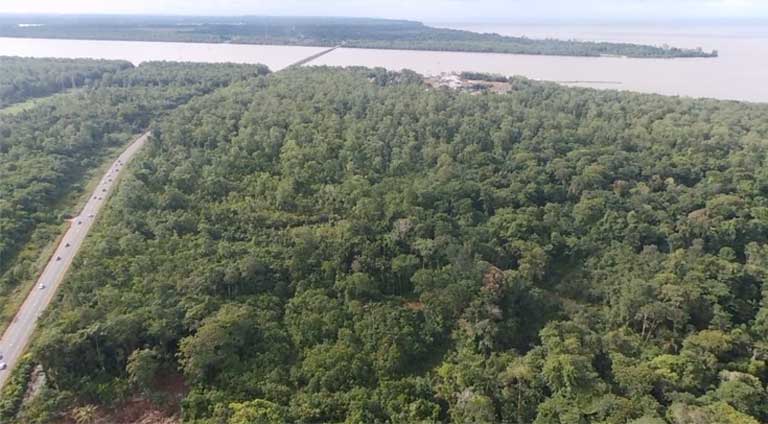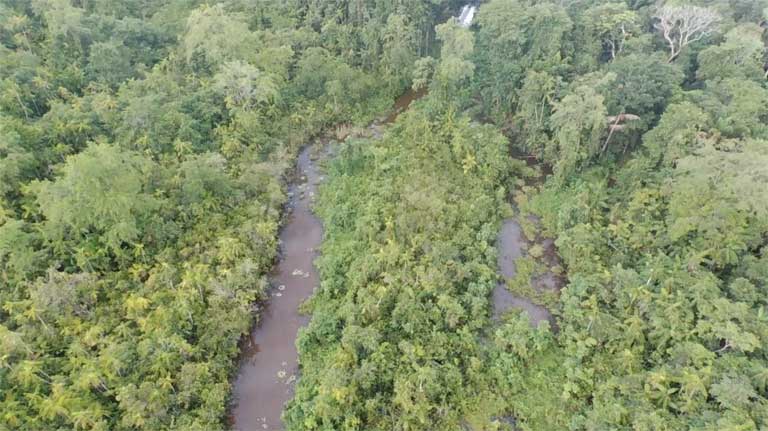- The French government, with the support of President Emmanuel Macron, appears eager to approve legislation that would bypass French environmental law banning large scale deforestation to build several soy-fired biofuel power plants in French Guiana — a French overseas department on the northeast coast of South America.
- Currently, 98% of this region is still covered in Amazon rainforest and mangrove forest. The largest of the proposed biofuel plants — Larivot in Cayenne, the French Guiana capital — would require between 84,000 and 140,000 metric tons of soy per year to generate enough liquid biofuel to power the 120-megawatt plant.
- Growing that much soy would require a large amount of rainforest clearing, totaling between 536 square miles and 892 square miles (nearly three times larger than the land area of New York City). Environmentalists are very concerned over the loss in forest carbon sequestration and harm to French Guiana’s Amazon biodiversity.
- “The fact that France is pushing for policy deviations in French Guiana from European Union sustainability standards is incredibly alarming.… There will be an impact on forests if they change the laws and it could be pretty massive,” said Almuth Ernsting, a biomass researcher with Biofuelwatch, an environmental NGO.

French Guiana, an overseas department of France on the northeast coast of South America, lies mostly within Amazonia. Bordered by Suriname and Brazil, 98% of this Indiana-sized area is covered by dense rainforests and mangrove — ecosystems chockful of biodiversity, critical to climate change mitigation, and now in the crosshairs of France’s long-term energy policy.
The French government launched a multiyear plan in 2018 to convert French Guiana’s aging energy infrastructure to power stations that will mostly burn biofuels — with major negative implications for the region’s wildlife, rainforests, carbon emissions, and by extension, global climate change mitigation.
“A local government representative has authorized the establishment of an oil-fired power station in a mangrove forest two miles from the edge of the Amazon forest,” says Francois Kuseni, an environmental activist and member of French Guiana’s Ecology Party from Cayenne, French Guiana’s capital city. In addition, “The government has promised a study of two years to supply the power station with bio oil. The representative said explicitly that they want to grow the soy plants [to be made into biofuel] locally.”
The overarching concern: French Guiana has limited available farmland (the region imports 80% of its food), so growing soy as a biofuel could lead to massive deforestation in a part of Amazonia already suffering widespread ecological devastation: French Guiana borders on the Brazilian Amazon where rapidly worsening annual wildfires, expanded ranching, agribusiness and illegal mining are causing widespread deforestation.

According to EDF, the French-owned energy utility, the largest of the proposed energy plants — Larivot in Cayenne — would require between 84,000 and 140,000 metric tons of soy per year to generate enough liquid biofuel to power a 120-megawatt plant. Growing that much soy would require a staggering amount of rainforest clearing, between 536 square miles (larger than Phoenix, Arizona) and 892 square miles (nearly three times the land area of New York City), according to estimates provided by Biofuelwatch in Scotland, an NGO that monitors the biomass industry globally.
It is important to note that those deforestation estimates could be low, according to Biofuelwatch.
Kuseni lives on the rainforest’s edge; so close to the jungle in fact, that monkeys sometimes sneak into his home in search of bananas. With tropical birds chirping in the background of our WhatsApp connection, he added, “I do not want them to cut our trees.”

A trans-Atlantic conflict
French Guiana, a part of France since the 18th Century, is beset today by rising crime and a 22% unemployment rate. Now, it also finds itself in the throes of a trans-Atlantic energy confrontation.
French authorities argue that the region’s antiquated power generation system — mostly decades-old diesel-fired power stations and aging hydroelectric plants — is inadequate to support French Guiana’s small but growing population, pressing upwards toward 300,000, and the need for updated and expanded energy production along the coast where most communities are concentrated.
Elected leaders say the proposed biofuel power plants, and the soy production required to support them, will generate much-needed employment, especially among young people — the fastest growing segment of French Guiana’s population.
But environmentalists counter that with Brazil, Peru and Bolivia losing thousands of hectares of Amazon rainforest annually to deforestation and wildfires, the intact and pristine rainforest of French Guiana — most of it classified as old-growth — become ever-more important for climate change mitigation and biodiversity conservation.

How green is France?
Green Party candidates swept local elections in France last spring, as they espoused an aggressive climate-action platform largely embraced by French President Emmanuel Macron. This radical platform includes a proposed national referendum that would make “ecocide” — intentional largescale harm done to the environment — a crime.
However, Macron, who visited French Guiana in 2017, has reportedly thrown his support behind the major biofuel energy transition in the region. While small solar installations would be part of Macron’s energy mix, most new power generation would come from biomass fired power plants. Some of that biomass would come from chipped wood and lumber waste, but most would be provided by liquid biofuels from local soy, grown where rainforest now stands.
“This is not green at all,” Kuseni said of the soy biofuel plan. “Most people in French Guiana say they do not want these kinds of power stations.”
Marine Calmet, a Paris-based environmental attorney with the NGO Wild Legal, is fighting to protect French Guiana’s rainforests, and she monitors the French Parliament for new legislation that could alter environmental protections in the South American department.
“We have problems with the green energy transition in [French Guiana],” Calmet said in a Mongabay interview. “We have all we need in terms of sun to provide solar energy there. But for now, we have a lot of new projects proposed for biomass. Our biggest challenge is not wood [as a biofuel resource], it is [soy] farming. They need large surfaces to do agriculture for biofuels and it would mean largescale destruction of primary forests in the Amazon.”
Current French law prohibits widespread deforestation in France and French Guiana. But that could change. On October 4, it almost did. An amendment tucked into a proposed law would have allowed requests for unlimited land leases in French Guiana to increase from 150 hectares to 5,000 hectares — thus, enabling industrial-scale land clearance for farming or mining. A source in Parliament alerted Calmet, and she helped rally opposition to defeat the legislation.
“We are struggling to keep our forests safe from these kinds of industries,” Calmet said. “It’s not only biomass, it’s mining and other predatory industries that want access to French Guiana and have been stopped for now by our environmental policies. But the government wants to change the law, so we know they will try again.”
Kuseni, noted that the French parliamentary majority rejected the October 4 legislation “so I think we are safe until 2022 — the date of the future presidential election. Nevertheless, we remain vigilant.”
Ironically, France has recently been seen as a leader in the battle to prevent significant deforestation from entering its food production supply chain — especially as related to soy grown in Brazil for animal feed, or used as an ingredient in food products sold by French grocery chains. However, environmental critics claim that this government policy contains loopholes, even though eight French supermarket chains now require their suppliers to obtain soybeans that were not grown on deforested land, as recently reported by Mongabay. Soy is associated with more deforestation than any other crop globally according to World Wildlife Fund, especially in the Brazilian Amazon.

The battle over biofuels
In all, five new biofuel-fired energy stations are proposed along the coast of French Guiana. Four are tiny — 5 megawatts or smaller — as compared to the 120-megawatt Larivot plant.
The French government, like the entire European Union, classifies biofuels as a renewable energy source on par with zero-carbon wind and solar energy. This zero-carbon classification (now hotly contested by science) was first approved by the United Nations as part of the 2005 Kyoto Protocol, then grandfathered into the 2016 Paris Climate Agreement, and it helps explain the push for biofuels in French Guiana.
In regard to its Voltalia biofuel power plant under construction in Cacao, French Guiana, for example, the government’s Agence Française de Développement (AFD) claims the 5.1-megawatt facility will reduce carbon emissions by 28,500 tons per year compared to current diesel-fired plants. However, this optimistic calculation is likely based on what scientists have dubbed as a United Nations carbon accounting loophole, thus not counting the emissions from biomass or biofuels because they are deemed a renewable energy source.
“Guiana is firmly committed to reconciling local energy needs with the environmental challenges of the 21st century as demonstrated by the new biomass plant slated to open in Cacao,” the ADF wrote. “Developing renewable energy sources, which already make up 50% of the Guyanese energy mix, is a crucial solution to meet this growing [energy] demand while also meeting the climate challenge.”
But critics challenge the assertion that biofuels are so climate-friendly. Massive Amazon deforestation will be required to create largescale soy farms — resulting in a significant loss in forest carbon sequestration. And despite the UN zero carbon designation, biofuels do produce carbon emissions, even though France has promised to install advanced pollution-control technology at its French Guiana biofuel plants.
Under EU law, emissions from biomass and biofuels are not presently counted toward Paris Agreement carbon reduction targets because organic materials such as trees and oil crops — including palm, soy or rapeseed — are listed as renewable energy sources, a legal designation European climate scientists have thus far unsuccessfully fought to change with research-based petitions to the EU Parliament.
A 2008 study published in Industrial Biotechnology compared the carbon footprints of biofuels and fossil fuels. The study’s authors emphasized: “It’s about the land.” There are circumstances, the authors stated, where biofuels from soy could be a better environmental choice than fossil fuels in terms of overall carbon emissions. But, they stressed, “Land use is absolutely a central issue… Greenhouse gas emissions [for example] are reduced more by [burning] gasoline and preserving the Brazilian rainforest, than knocking it down to grow sugarcane for bioethanol.”
Almuth Ernsting, a biomass researcher with Biofuelwatch in Scotland, is closely following developments in France and French Guiana. She said she is most concerned by the French government’s apparent eagerness to change forest protection laws in its South American overseas department — while not altering regulations in France and within the EU.
“The fact that France is pushing for policy deviations in French Guiana from European Union sustainability standards is incredibly alarming,” she said. “There will be an impact on forests if they change the laws and it could be pretty massive.”
Justin Catanoso is a regular contributor to Mongabay and a professor of journalism at Wake Forest University in North Carolina, USA. Follow him on Twitter @jcatanoso
Banner image: A spider monkey in French Guiana. Photo credit: Sean McCann (ibycter.com) on VisualHunt.com / CC BY-NC-SA
FEEDBACK: Use this form to send a message to the author of this post. If you want to post a public comment, you can do that at the bottom of the page.
